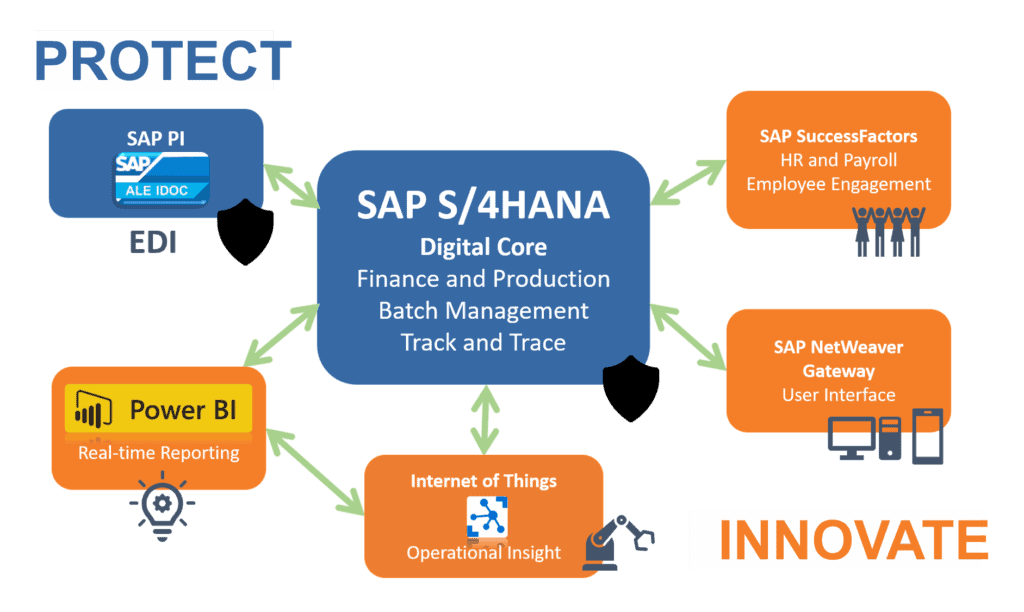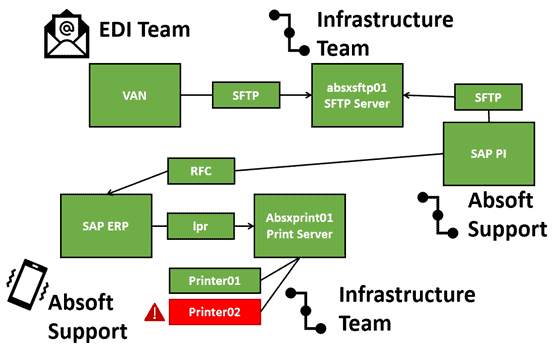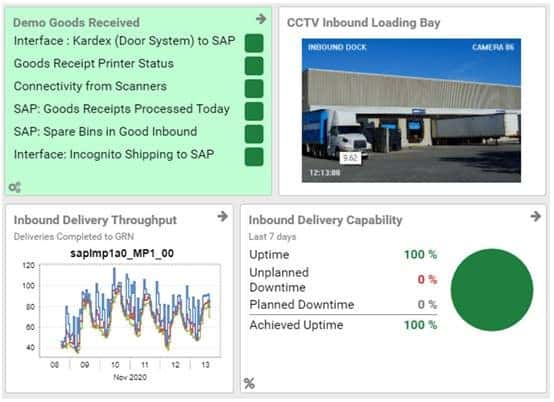Companies in the FMCG sector require continuous innovation throughout their SAP processes. This is especially true for their SAP operations. Absoft has been helping the FMCG sector keep up with the growing and changing demand through SAP innovations for decades.
In this article Robert MacDonald, Innovation and Technology Manager at Absoft shares what innovations are crucial for the sector. He also addresses why these are important and the impact they can have. Here are the five top tips addressing the most crucial concepts to ensure optimal SAP operations:
 1. An Architecture for Innovation and Integration
2. Cost-effective availability
3. EDI is more important than SAP
4. Make performance improvements where it matters
5. Spend time on the shop floor
1. An Architecture for Innovation and Integration
Innovation
Systems are difficult to change when they are mission critical for 24/7 production operations. Legislative requirements in batch management and track and trace make changes legally complicated. Adding recipe management into the mix means compliance with nutritional regulations also depends on predictable behaviour from SAP.
Innovation requires a system you can change, test and fail fast when required. Rapidly ascertaining if a new idea works is key to innovation management and gaining competitive edge.
Borrowing from some related experience in the pharmaceutical industry, I recommend finding an architecture that protects a digital core for ERP with innovation possible on the edges.

Many of our customers run a separate system for fast-changing functionality, like running HR and Payroll. Constant legal changes and update requirements are very disruptive in the core ERP. In a secondary ERP system or in external products like SuccessFactors, innovation can happen safely.
Integration
Integration with cloud services from Microsoft Azure is getting easier as SAP and Microsoft continue their partnership. We develop Power BI reports for our customers based on live SAP data allowing a dynamic and flexible reporting environment for any real-time information you can get value from.
Securely using the data from shop floor machinery is a holy grail for many. Imagine what you can do if you know exactly what is going on everywhere in real-time. Azure is perfect to handle and process that data. Meaningful actions can be posted into SAP through BAPI integration from Azure Logic Apps, amongst others.
The user interface is an easy component to bring out of the core, through a separate hub gateway deployment for SAP Fiori. Constantly tuning the user experience lets you make micro-changes to optimise the most repetitive tasks on the shop floor.Â
2. Cost-effective availability
The FMCG industry has some of the most challenging availability requirements possible. 24/7 operations are standard and it often has no ability to recover from downtime. Conversely, commercial pressure from the supermarkets and open-book cost pricing make it impossible to accept complex and expensive high availability clusters for SAP.
Nevertheless, we have moved SAP systems into Microsoft Azure for multiple clients in this demanding sector. We use the functionality of Microsoft Azure to offer high availability without expensive clustering.
- 99.9% availability SLAs on a single Virtual Machine
- Service healing capability to bring SAP back online immediately in the event of a failure
- Automated disaster recovery with backups synchronised to alternative regions
- >99.95% availability of Azure connections with Active-Active VPNs and ExpressRoute
99.9% sounds like low availability, but it must be compared to what is being replaced. We are often replacing the old faithful server that has run SAP applications for longer than its anticipated service life, and any breakdown would have required a wait for parts. In Azure with service healing and Absoft’s automated monitoring, any server fault that affects SAP is recovered in under an hour.
Of course, high availability clusters are required for very high volume and larger operations, where the costs of running and maintaining the cluster outweigh the downsides of any downtime at all, even of one hour. It is important that the decision for availability is a finance one and not a technical one. Therefore, the costs and implications of downtime must be compared to the costs of high availability.
3. EDI is more important than SAP
EDI (Electronic Data Interchange) is the backbone of the FMCG industry. Without it there are no orders. no invoices and everything stops.
In my first experience with FMCG I quickly became aware that the interface to the customers is often the main purpose of SAP. Even where SAP is a true production system running the shop floor, it can’t do anything without EDI.
It is critical for operations teams to focus on what is most crucial to the business, not minor technical fault in their area of focus. Therefore we build dashboards of real-time monitoring information for every part of the crucial interfaces, across SAP and non-SAP systems. Additionally, we set up alerting to the right people as this brings our close relationships with customer teams into the automation that supports our work.

Business process monitoring means monitoring all the technical components that make up a complete business process. For production that could be everything from the EDI interfaces for the orders coming in, through to functional data in SAP and data from production systems and even machinery. It’s not unheard of to bring CCTV footage into a dashboard!
You might wonder why this monitoring is relevant to SAP operations specifically. We do it to ensure we are focusing on what really has an impact. A failed background job in a QA system is important to pick up, but a minor fault in an interface to a shop floor system could have far greater ramifications when viewed in content. Context is king when it comes to monitoring.
4. Make performance improvements where it matters
Finding and fixing performance issues in SAP systems is addictive. Little is more rewarding than finding something that is running slowly and streamlining it. Solving the puzzle is a reward. Most importantly, optimising a process has a huge impact for people actually using the system.
Fixing slow reports is easiest. A report that uses an unoptimised database query can easily be changed in a wizard-like night and day fashion. It is very rewarding for the person who runs it once a month. They shower you with praise and everyone feels great.
Optimising a fast process is harder, however this has the most value for FMCG operations. If you can knock milliseconds off the time between a barcode scan and a label printing in a place that scans thousands of barcodes and prints thousands of labels, you can make a measurable production increase with no cost.
For instance, optimising a monthly report can reduce the time it takes from 10 minutes to 13 seconds, the equivalent to gaining back the time from an employee taking a coffee break. On the other hand, optimising a barcode scan and reducing it from 535ms to 295ms, 20,000 times a day will have a massive impact. The production increase here is equal to a employing a full-time employee, for free.
To find what to optimise, I use the traditional SAP tools like the ST03N workload collector. I always sort by total time across all executions, or number of executions, to find likely candidates. Analysing similar data from the DBA Cockpit is also a way to root out queries that are run most frequently and will have the biggest impact.
Of course, the best way to find out what will make an impact is…
5. Spend time on the shop floor
Spending time on the shop floor provides invaluable insight. Very early in my career I was working on a support transition for a newly implemented Warehouse Management system. The whole differentiator for the distribution business was their complex picking processes. The new implementation of SAP EWM was kept busy sending forklift drivers around a huge warehouse to fill orders.
Casually standing in the warehouse troubleshooting some wi-fi performance issue for the handhelds, a driver mentioned that ‘the pillars are a bit annoying.’ It turned out that SAP had all the state-of-the-art configuration to work out the most optimal picking order based on warehouse layout, but it didn’t take into account the pillars in some aisles that blocked the obvious route.

I’m not sure how long they had been driving the long way back and forth, or how long they would have done so before anybody realised what was happening. The lost time and fuel would have certainly added up to a lot more than the quick, easy, and free configuration change that resolved the issue.
Spending time in the factory, including the effort to don hairnets and shoe covers, is invaluable to understand what is important to the users. Talking to people, watching people working and asking the foreman what is really bothering him this week all provide more valuable information to SAP operations teams than any EarlyWatch Report (However, EarlyWatch Reports are also very useful and highly recommended).
SAP FMCG and Absoft
Customer’s needs perpetually change when it comes to SAP Managed Services, especially in SAP FMCG operations. Subsequently, constant re-invention and evolution are necessary for your service provider to meet your demands. Continuous development and re-invention typifies Absoft’s SAP Managed Service. In other words, it is bespoke to your business. This ensures our service meets your SAP FMCG operation demands for secure, digitalised, improved automated services and processes.
Article by:Â Robert MacDonald, Innovation and Technology Manager
Bob is responsible for bringing the latest SAP technology to Absoft and its customers across industry sectors. From a technical background, he specialises in identifying efficiencies in running SAP through automation, monitoring and optimisation. He has worked on supporting, implementing and upgrading SAP for over 10 years, and is now launching the newest innovations in automation.











